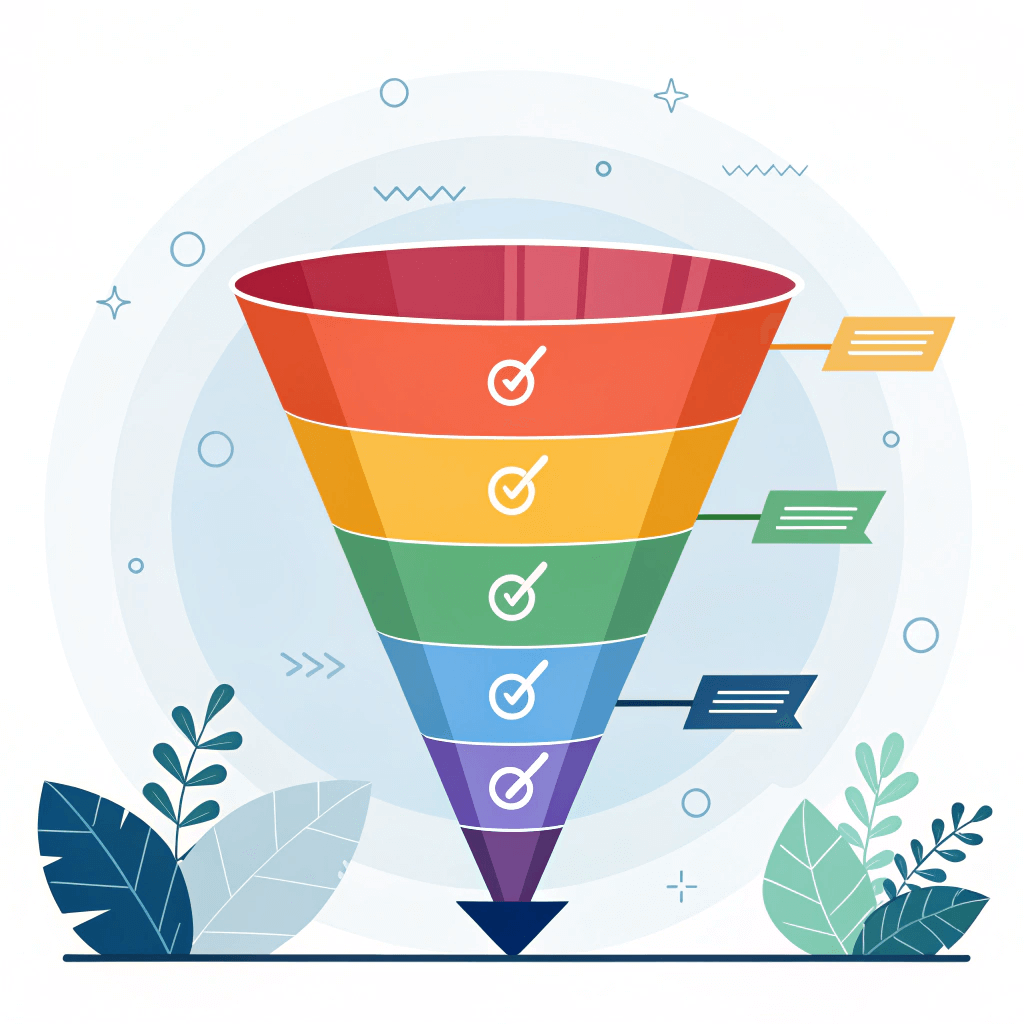Every marketer loves to talk about “funnels.” But let’s be honest — most people don’t really know what that means beyond a vague shape that narrows down. In 2026, the marketing funnel is not just a model. It’s a living, breathing ecosystem that mirrors how humans actually make decisions in a noisy, over-stimulated digital world.
Its like dating if you want the comparison
Think of it like dating. You don’t propose on the first message (well, hopefully). You build awareness, show interest, create desire, and eventually, get commitment. The marketing funnel follows the same rhythm, from awareness to purchase, guiding your potential customers one step closer until they say yes with their wallet.
And in 2026, with all the tools, AI systems, and automation platforms around, it’s never been more exciting… or more complicated.
Let’s dive into how you can build, analyze, and master your marketing funnel to actually make it work, not just sound cool in a presentation.
What Is a Marketing Funnel (and Why It Still Matters in 2026)?
At its simplest, a marketing funnel represents the stages your customer travels through — from discovering your brand to becoming a loyal advocate. Traditionally, it’s broken into stages like Awareness, Interest, Consideration, Intent, and Purchase. But modern marketing funnels are more fluid.
Customers can jump back and forth between stages, influenced by social proof, personalization, and even your competitors’ ads that stalk them around the web like a jealous ex.
Funnels arent linear anymore
In 2026, the funnel isn’t linear anymore. People see your TikTok ad, then read a Reddit thread about your product, then click a YouTube review, and only then might visit your website. You’re not just “guiding” them — you’re juggling multiple channels and attention spans that last about as long as a goldfish doing yoga.
Yet, mastering the funnel is crucial. It gives you structure, measurable checkpoints, and a way to identify where people drop off. That’s where your data tools come in — whether you’re using something advanced like PrettyInsights, HubSpot, or even your own spreadsheets if you like pain.
The Five Core Stages of a Modern Marketing Funnel
Let’s break down the funnel as it actually works in 2026 — not in some dusty marketing textbook from 2009.
1. Awareness
This is where your audience first hears about you. The goal? To make noise but the right kind of noise. Awareness campaigns are all about reaching people who have no clue who you are. Social media ads, SEO blogs, YouTube videos, influencer shoutouts, podcasts, or even memes — everything that gets eyes on your brand counts here.
The key is relevance. You don’t just want traffic; you want the right traffic. Use analytics tools to track what channels drive attention and what keywords or creatives spark curiosity.
And please, don’t post another “We’re thrilled to announce…” update on LinkedIn. Nobody’s thrilled. Make it human. Make it memorable.
2. Interest
Once they’ve heard of you, you need to hold their attention before someone else does. This stage is about storytelling, not selling. You should be building trust and curiosity. Think free webinars, interactive guides, or even entertaining social content that educates.
The goal is simple — make them care enough to click again. Use email captures, retargeting, and personalized follow-ups to keep your name on their screen (and hopefully their mind).
I like to call this phase the “first date” stage of marketing. You’re not closing yet, you’re showing your best self — without overselling or sending creepy automated DMs at 2 a.m.
3. Consideration
Now, they’re comparing. They’re looking at you and your competitors, reading reviews, watching testimonials, and maybe even chatting with your chatbot. The content here should educate and differentiate.
This is where content marketing becomes your silent salesperson. Case studies, product demos, comparison pages, and customer stories do the talking for you.
Here’s a little secret: the consideration stage is where good brands stand out, and lazy ones fade away. If you haven’t answered your customer’s biggest fears and questions by now, someone else will.
4. Intent
At this point, the customer is almost ready to buy. They’ve added something to their cart, requested a demo, or filled out a form. The challenge? Don’t scare them off with friction or boring follow-ups.
Your goal here is to make the decision as effortless as possible. Add trust badges, simplify checkout, offer live chat support, or give them that final nudge — like a discount, limited offer, or social proof.
This is where personalization works magic. A well-timed email that says, “Hey, you left this in your cart — still interested?” often works better than any fancy campaign.
5. Purchase
Finally, the sweet spot — conversion. But here’s where most businesses drop the ball. They treat purchase like the end of the journey when it’s really the start of a new one.
You’ve got the sale — now turn that buyer into a loyal fan. Follow up with thank-you emails, surveys, tutorials, or even surprise discounts. Every small post-purchase touch builds trust and turns one-time buyers into long-term advocates.
And if you can automate all this with tools like Omnisend or PrettyInsights’ CRM integrations? You’ll have a system that sells while you sleep. Not bad, right?
Why Marketing Funnels Are More Human Than Ever
Here’s something wild — in 2026, the best funnels aren’t built for algorithms. They’re built for humans. AI might write your email, but emotion closes the sale.
People crave connection. They buy from brands that get them, brands that speak their language, and brands that don’t act like soulless robots. Every touchpoint in your funnel — whether it’s a chatbot or an Instagram post — should feel like it was written by a real person.
Let me tell you a small story. I once subscribed to a brand’s email just because they wrote, “We hate spam too, but this one’s actually worth your time.” That’s charm. That’s voice. You remember those brands because they don’t sound like corporate oatmeal.
So, even as you automate your workflows, never automate your personality.
How to Build a High-Converting Funnel (Step-by-Step)
Let’s make this practical. You can build your marketing funnel in five clear steps:
- Define your audience – Who are they? What do they need? Where do they hang out online?
- Map the stages – Create touchpoints for Awareness, Interest, Consideration, Intent, and Purchase.
- Create content for each stage – Blog posts, lead magnets, demos, testimonials — mix it up.
- Automate smartly – Use email sequences, retargeting, and chatbots that actually help, not annoy.
- Measure everything – Track KPIs like conversion rate, drop-off points, and ROI to refine.
See? It’s not rocket science. But it does require attention to detail and a deep understanding of how people behave.
Advanced Funnel Strategies for 2026
Marketing funnels used to be one-size-fits-all. Not anymore. The smartest marketers in 2026 use segmented, personalized, and multi-channel funnels that adapt in real time.
AI tools now allow you to tailor the experience to each visitor. Imagine your funnel knowing when someone prefers to read long guides instead of watching videos — and adjusting automatically. That’s not futuristic fantasy anymore; it’s already happening.
Another hot trend? Micro-funnels. Instead of one giant system, companies create mini-funnels for specific campaigns or audiences. For example, one funnel for SaaS free trials, another for enterprise leads, and another for upselling existing customers.
And don’t forget data-driven testing. A/B testing isn’t just about colors and buttons anymore. You can now test full user journeys, email cadences, and ad sequences — even predict churn before it happens.
Common Funnel Mistakes You Should Avoid
Let’s face it: most funnels fail not because of bad strategy, but bad execution. Here are the usual suspects:
- Too many steps: You’re not building a maze. Keep it simple.
- No personalization: Generic emails are the fast lane to “unsubscribe.”
- Ignoring analytics: If you don’t track behavior, you’re just guessing.
- Weak CTAs: “Click here” isn’t compelling. “Get your free strategy plan” is.
- No follow-up: People rarely buy on first contact. Stay consistent, not desperate.
- Not using a good and comprehensive event tracking or product analytics tool
I’ve seen companies spend thousands on ads only to forget to send a single follow-up email. Don’t be that company.
Measuring Funnel Performance (Like a Pro)
Data is your compass. Without it, you’re wandering in marketing fog. Each stage of your funnel has metrics that tell a story:
- Awareness: Website visits, impressions, engagement rates.
- Interest: Click-throughs, time on page, email sign-ups.
- Consideration: CTA clicks, demo requests, repeat visits.
- Intent: Cart adds, replies, or final-stage form submissions.
- Purchase: Conversion rates, customer lifetime value (CLV), repeat sales.
If you’re using modern analytics tools like PrettyInsights or GA4, you can visualize where people drop off and fix it fast. That’s the real power of conversion funnel analytics — seeing what’s broken and patching it before you lose more sales.
The Rise of Omnichannel Funnels
In 2026, funnels don’t just live on your website. They exist across emails, apps, social platforms, and even voice assistants. Omnichannel funnels ensure every experience is consistent and connected.
Picture this: someone discovers you on Instagram, reads your blog, signs up for a free trial on desktop, and later completes the purchase on mobile. Every touchpoint should feel like part of one seamless experience. That’s how you build brand trust — not through gimmicks, but through coherence.
Conclusion
Mastering the marketing funnel in 2026 isn’t about stuffing people into a rigid process. It’s about understanding human behavior, meeting your audience where they are, and guiding them with empathy, creativity, and data.
Your funnel is your growth engine. It works silently behind the scenes — nurturing, converting, and delighting. If you refine it continuously, it becomes your unfair advantage.
And remember: funnels don’t sell products. People do. Make yours authentic, adaptive, and human.
Now go build a funnel so good that even your competitors end up subscribing to your newsletter.

